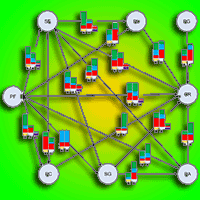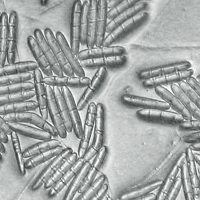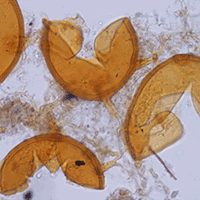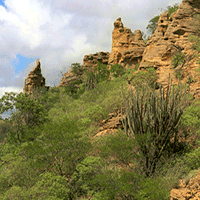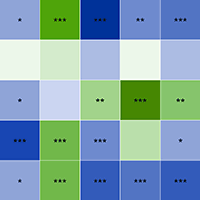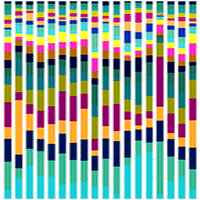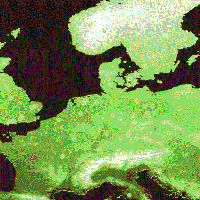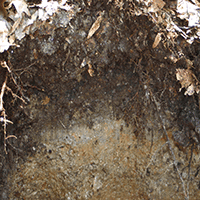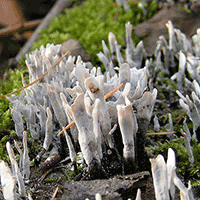Land use change is one of the major causes of biodiversity loss, mostly due to habitat change and fragmentation. Belowground fungal diversity is very important in terrestrial ecosystems, however, the effect of land use change on soil fungal community is poorly understood. In this review, a total of 190 studies worldwide were analyzed. To monitor the effect of land use change, different fungal parameters such as richness, diversity, community composition, root colonization by arbuscular mycorrhizal (AM) and ectomycorrhizal (ECM) fungi, spore density, ergosterol, and phospholipid fatty acid (PLFA) content and AM fungal glomalin related soil protein (GRSP) were studied. In general, results from analyzed studies often showed a negative response of fungal quantitative parameters after land use change from less-intensive site management to intensive site management. Land use change mostly showed significant shifts in fungal community composition. Considering land use change types, only 18 out of 91 land use change types were included in more than 10 studies, conversion of primary and secondary forest to various, more intensive land use was most often represented. All these 18 types of land use change influenced fungal community composition, however, the effects on quantitative parameters were mostly inconsistent. Current knowledge is not sufficient to conclude general land use impacts on soil fungi as the reviewed studies are fragmented and limited by the local context of land use change. Unification of the methodology, detailed descriptions of environmental factors, more reference sequences in public databases, and especially data on ecology and quantitative parameters of key fungal species would significantly improve the understanding of this issue.
Keywords
, , , ,
Citation
Balami S, Vašutová M, Godbold D, Kotas P, Cudlín P (2020). Soil fungal communities across land use types. iForest 13: 548-558. - doi: 10.3832/ifor3231-013
Academic Editor
Alberto Santini
Paper history
Received: Sep 08, 2019
Accepted: Sep 17, 2020
First online: Nov 23, 2020
Publication Date: Dec 31, 2020
Publication Time: 2.23 months
© SISEF - The Italian Society of Silviculture and Forest Ecology 2020
Open Access
This article is distributed under the terms of the Creative Commons Attribution-Non Commercial 4.0 International (https://creativecommons.org/licenses/by-nc/4.0/), which permits unrestricted use, distribution, and reproduction in any medium, provided you give appropriate credit to the original author(s) and the source, provide a link to the Creative Commons license, and indicate if changes were made.

Breakdown by View Type
(Waiting for server response...)
Article Usage
Total Article Views: 43188
(from publication date up to now)
Breakdown by View Type
HTML Page Views: 33269
Abstract Page Views: 5529
PDF Downloads: 3653
Citation/Reference Downloads: 18
XML Downloads: 719
Web Metrics
Days since publication: 1852
Overall contacts: 43188
Avg. contacts per week: 163.24
Article Citations
Article citations are based on data periodically collected from the Clarivate Web of Science web site
(last update: Mar 2025)
Total number of cites (since 2020): 17
Average cites per year: 2.83
Publication Metrics
by Dimensions ©
Articles citing this article
List of the papers citing this article based on CrossRef Cited-by.
(1)
Agrios GN (2005)Plant pathology (5th edn). Academic Press, London, UK, pp. 358-611.
Gscholar
(2)
Albornoz FE, Lambers H, Turner BL, Teste FP, Laliberté E (2016)Shifts in symbiotic associations in plants capable of forming multiple root symbioses across a long-term soil chronosequence. Ecology and Evolution 6: 2368-2377.
CrossRef |
Gscholar
(3)
Bainard LD, Chagnon PL, Cade-Menun BJ, Lamb EG, LaForge K, Schellenberg M, Hamel C (2017)Plant communities and soil properties mediate agricultural land use impacts on arbuscular mycorrhizal fungi in the Mixed Prairie ecoregion of the North American Great Plains. Agriculture, Ecosystems and Environment 249: 187-195.
CrossRef |
Gscholar
(4)
Balser TC, Treseder KK, Ekenler M (2005)Using lipid analysis and hyphal length to quantify AM and saprotrophic fungal abundance along a soil chronosequence. Soil Biology and Biochemistry 37: 601-604.
CrossRef |
Gscholar
(5)
Bedini S, Avio L, Argese E, Giovannetti M (2007)Effects of long-term land use on arbuscular mycorrhizal fungi and glomalin-related soil protein. Agriculture, Ecosystems and Environment 120: 463-466.
CrossRef |
Gscholar
(6)
Boddington CL, Dodd JC (2000)The effect of agricultural practices on the development of indigenous arbuscular mycorrhizal fungi. I. Field studies in an Indonesian ultisol. Plant and Soil 218: 137-144.
CrossRef |
Gscholar
(7)
Briassoulis H (2019)Analysis of land use change: theoretical and modeling approaches. Web Book of Regional Science 3, Regional Research Institute, West Virginia University, Morgantown, WV, USA, pp 11-12.
Gscholar
(8)
Brinkmann N, Schneider D, Sahner J, Ballauff J, Edy N, Barus H, Irawan B, Budi SW, Qaim M, Daniel J, Polle A (2019)Intensive tropical land use massively shifts soil fungal communities. Scientific Reports 9 (1): 16732.
CrossRef |
Gscholar
(9)
Brundrett MC (2009)Mycorrhizal associations and other means of nutrition of vascular plants: understanding the global diversity of host plants by resolving conflicting information and developing reliable means of diagnosis. Plant and Soil 320: 37-77.
CrossRef |
Gscholar
(10)
Carini P, Marsden PJ, Leff JW, Morgan EE, Strickland MS, Fierer N (2017)Relic DNA is abundant in soil and obscures estimates of soil microbial diversity. Nature Microbiology 2 (3): 37.
CrossRef |
Gscholar
(11)
Castaneda LE, Godoy K, Manzano M, Marquet PA, Barbosa O (2015)Comparison of soil microbial communities inhabiting vineyards and native sclerophyllous forests in central Chile. Ecology and Evolution 5: 3857-3868.
CrossRef |
Gscholar
(12)
Daniels BA, Skipper HD (1982)Methods for the recovery and quantitative estimation of propagules from soil. In: “Methods and Principles of Mycological Research” (Schenck NC). The American Phytopathological Society, St. Paul, MN, USA, pp. 29-35.
Gscholar
(13)
Dinesh R, Chaudhuri SG (2013)Soil biochemical/microbial indices as ecological indicators of land use change in mangrove forests. Ecological Indicators 32: 253-258.
CrossRef |
Gscholar
(14)
Dix NJ, Webster J (2012)Fungal ecology (1st edn). Springer Science and Business Media, London, UK, pp. 1-5.
Online |
Gscholar
(15)
Don A, Schumacher J, Freibauer A (2011)Impact of tropical land-use change on soil organic carbon stocks-a meta-analysis. Global Change Biology 17: 1658-1670.
CrossRef |
Gscholar
(16)
Dong X, Huai-Ying Y, De-Yong GE, Huang CY (2008)Soil microbial community structure in diverse land use systems: a comparative study using Biolog, DGGE, and PLFA analyses. Pedosphere 18: 653-663.
CrossRef |
Gscholar
(17)
Drenovsky RE, Steenwerth KL, Jackson LE, Scow KM (2010)Land use and climatic factors structure regional patterns in soil microbial communities. Global Ecology and Biogeography 19: 27-39.
CrossRef |
Gscholar
(18)
Drew EA, Murray RS, Smith SE, Jakobsen I (2003)Beyond the rhizosphere: growth and function of arbuscular mycorrhizal external hyphae in sands of varying pore sizes. Plant and Soil 251: 105-114.
CrossRef |
Gscholar
(19)
Driver JD, Holben WE, Rillig MC (2005)Characterization of glomalin as a hyphal wall component of arbuscular mycorrhizal fungi. Soil Biology and Biochemistry 37: 101-106.
CrossRef |
Gscholar
(20)
Fokom R, Adamou S, Teugwa MC, Boyogueno AB, Nana WL, Ngonkeu MEL, Zollo PA (2012)Glomalin related soil protein, carbon, nitrogen and soil aggregate stability as affected by land use variation in the humid forest zone of south Cameroon. Soil Tillage Research 120: 69-75.
CrossRef |
Gscholar
(21)
FAO (2016)State of the world’s forests 2016 - Forests and agriculture: land use challenges and opportunities. FAO Report, Food and Agriculture Organization of the United Nations, Rome, Italy, pp. 10-23.
Gscholar
(22)
Frostegård A, Tunlid A, Bååth E (2011)Use and misuse of PLFA measurements in soils. Soil Biology and Biochemistry 43: 1621-1625.
CrossRef |
Gscholar
(23)
Gherghel F, Behringer D, Haubrich S, Schlau M, Fey-Wagner C, Rexer KH, Kost G (2014)Former and host genotype influence the mycorrhizal colonization of poplar roots. Forests 5: 2980-2995.
CrossRef |
Gscholar
(24)
Grantina L, Seile E, Kenigsvalde K, Kasparinskis R, Tabors G, Nikolajeva V, Muiznieks I (2011)The influence of the land use on abundance and diversity of soil fungi: comparison of conventional and molecular methods of analysis. Environmental and Experimental Biology 9: 9-21.
Gscholar
(25)
Guadarrama P, Castillo-Argüero S, Ramos-Zapata JA, Camargo-Ricalde SL, Alvarez-Sánchez J (2008)Propagules of arbuscular mycorrhizal fungi in a secondary dry forest of Oaxaca, Mexico. Revista de Biologia Tropical 56: 269-277.
Online |
Gscholar
(26)
Guo LB, Gifford RM (2002)Soil carbon stocks and land use change: a meta-analysis. Global Change Biology 8: 345-360.
CrossRef |
Gscholar
(27)
Hamer U, Makeschin F, Stadler J, Klotz S (2008)Soil organic matter and microbial community structure in set-aside and intensively managed cropland soils in NE-Saxony, Germany. Applied Soil Ecology 40: 465-475.
CrossRef |
Gscholar
(28)
Hazard C, Gosling P, Mitchell DT, Doohan FM, Bending GD (2014)Diversity of fungi associated with hair roots of ericaceous plants is affected by land use. FEMS Microbiology Ecology 87: 586-600.
CrossRef |
Gscholar
(29)
Heinemeyer A, Ridgway KP, Edwards EJ, Benham DG, Young JPW, Fitter AH (2004)Impact of soil warming and shading on colonization and community structure of arbuscular mycorrhizal fungi in roots of a native grassland community. Global Change Biology 10: 52-64.
CrossRef |
Gscholar
(30)
Honnay O, Helsen K, Van Geel M (2017)Plant community reassembly on restored semi-natural grasslands lags behind the assembly of the arbuscular mycorrhizal fungal communities. Biological Conservation 212: 196-208.
CrossRef |
Gscholar
(31)
Hrynkiewicz K, Toljander YK, Baum C, Fransson PM, Taylor AF, Weih M (2012)Correspondence of ectomycorrhizal diversity and colonisation of willows (
Salix spp.) grown in short rotation coppice on cropland sites and adjacent natural stands. Mycorrhiza 22: 603-613.
CrossRef |
Gscholar
(32)
Islas AT, Guijarro KH, Eyherabide M, Rozas HS, Echeverría HE, Covacevich F (2016)Can soil properties and agricultural land use affect arbuscular mycorrhizal fungal communities indigenous from the Argentinean Pampas soils? Applied Soil Ecology 101: 47-56.
CrossRef |
Gscholar
(33)
Jefwa JM, Okoth S, Wachira P, Karanja N, Kahindi J, Njuguini S, Huising J (2012)Impact of land use types and farming practices on occurrence of arbuscular mycorrhizal fungi (AM fungi) Taita-Taveta district in Kenya. Agriculture, Ecosystems and Environment 157: 32-39.
CrossRef |
Gscholar
(34)
Kasel S, Bennett LT, Tibbits J (2008)Land use influences soil fungal community composition across central Victoria, south-eastern Australia. Soil Biology and Biochemistry 40: 1724-1732.
CrossRef |
Gscholar
(35)
Kerfahi D, Tripathi BM, Dong K, Go R, Adams JM (2016)Rainforest conversion to rubber plantation may not result in lower soil diversity of bacteria, fungi, and nematodes. Microbial Ecology 72: 359-371.
CrossRef |
Gscholar
(36)
Li JJ, Zheng YM, Yan JX, Li HJ, He JZ (2013)Succession of plant and soil microbial communities with restoration of abandoned land in the Loess Plateau, China. Journal of Soils and Sediments 13: 760-769.
CrossRef |
Gscholar
(37)
Lumini E, Orgiazzi A, Borriello R, Bonfante P, Bianciotto V (2010)Disclosing arbuscular mycorrhizal fungal biodiversity in soil through a land-use gradient using a pyrosequencing approach. Environmental Microbiology 12: 2165-2179.
CrossRef |
Gscholar
(38)
Makiola A, Dickie IA, Holdaway RJ, Wood JR, Orwin KH, Glare TR (2019)Land use is a determinant of plant pathogen alpha - but not beta - diversity. Molecular Ecology 16: 3786-3798.
CrossRef |
Gscholar
(39)
Manoharan L, Rosenstock NP, Williams A, Hedlund K (2017)Agricultural management practices influence AM fungi diversity and community composition with cascading effects on plant productivity. Applied Soil Ecology 115: 53-59.
CrossRef |
Gscholar
(40)
McGuire KL, D’Angelo H, Brearley FQ, Gedallovich SM, Babar N, Yang N, Mansor P (2015)Responses of soil fungi to logging and oil palm agriculture in Southeast Asian tropical forests. Microbial Ecology 69: 733-747.
CrossRef |
Gscholar
(41)
McLean M, Huhta V (2002)Microfungal community structure in anthropogenic birch stands in central Finland. Biology and Fertility of Soils 35: 1-12.
CrossRef |
Gscholar
(42)
Melo CD, Walker C, Rodríguez-Echeverría S, Borges PA, Freitas H (2014)Species composition of arbuscular mycorrhizal fungi differ in semi-natural and intensively managed pastures in an isolated oceanic island (Terceira, Azores). Symbiosis 64: 73-85.
CrossRef |
Gscholar
(43)
Moora M, Davison J, Opik M, Metsis M, Saks U, Jairus T, Zobel M (2014)Anthropogenic land use shapes the composition and phylogenetic structure of soil arbuscular mycorrhizal fungal communities. FEMS Microbiology Ecology 90: 609-621.
CrossRef |
Gscholar
(44)
Moragues-Saitua L, Merino-Martín L, Stokes A, Staunton S (2019)Towards meaningful quantification of glomalin-related soil protein (GRSP) taking account of interference in the Coomassie Blue (Bradford) assay. European Journal of Soil Science 70: 727-735.
CrossRef |
Gscholar
(45)
Mueller RC, Rodrigues JL, Nüsslein K, Bohannan BJ (2016)Land use change in the Amazon rain forest favours generalist fungi. Functional Ecology 30: 1845-1853.
CrossRef |
Gscholar
(46)
Muleta D, Assefa F, Nemomissa S, Granhall U (2008)Distribution of arbuscular mycorrhizal fungi spores in soils of smallholder agroforestry and monocultural coffee systems in southwestern Ethiopia. Biology and Fertility of Soils 44: 653-659.
CrossRef |
Gscholar
(47)
Muthukumar T, Sha L, Yang X, Cao M, Tang J, Zheng Z (2003)Distribution of roots and arbuscular mycorrhizal associations in tropical forest types of Xishuangbanna, southwest China. Applied Soil Ecology 22: 241-253.
CrossRef |
Gscholar
(48)
Nautiyal P, Rajput R, Pandey D, Arunachalam K, Arunachalam A (2019)Role of glomalin in soil carbon storage and its variation across land uses in temperate Himalayan regime. Biocatalysis and Agricultural Biotechnology 21: 101311.
CrossRef |
Gscholar
(49)
Nguyen NH, Song Z, Bates ST, Branco S, Tedersoo L, Menke JS, Kennedy PG (2016)FUNGuild: an open annotation tool for parsing fungal community datasets by ecological guild. Fungal Ecology 20: 241-248.
CrossRef |
Gscholar
(50)
Naranjo-Ortiz MA, Gabaldón T (2019)Fungal evolution: diversity, taxonomy and phylogeny of the Fungi. Biological Reviews 94: 2101-2137.
CrossRef |
Gscholar
(51)
Oehl F, Sieverding E, Ineichen K, Mäder P, Boller T, Wiemken A (2003)Impact of land use intensity on the species diversity of arbuscular mycorrhizal fungi in agroecosystems of Central Europe. Applied and Environmental Microbiology 69: 2816-2824.
CrossRef |
Gscholar
(52)
Oehl F, Sieverding E, Ineichen K, Maeder P, Wiemken A, Boller T (2009)Distinct sporulation dynamics of arbuscular mycorrhizal fungal communities from different agroecosystems in long-term microcosms. Agriculture, Ecosystems and Environment 134: 257-268.
CrossRef |
Gscholar
(53)
Oehl F, Laczko E, Bogenrieder A, Stahr K, Bösch R, Van Der Heijden M, Sieverding E (2010)Soil type and land use intensity determine the composition of arbuscular mycorrhizal fungal communities. Soil Biology and Biochemistry 42: 724-738.
CrossRef |
Gscholar
(54)
Okubo A, Sugiyama SI (2009)Comparison of molecular fingerprinting methods for analysis of soil microbial community structure. Ecological Research 24 (6): 1399-1405.
CrossRef |
Gscholar
(55)
Oliveira SP, Cndido MJD, Weber OB, Xavier FAS, Escobar MEO, Oliveira TS (2016)Conversion of forest into irrigated pasture I. Changes in the chemical and biological properties of the soil. Catena 137: 508-516.
CrossRef |
Gscholar
(56)
Olsson PA (1999)Signature fatty acids provide tools for determination of the distribution and interactions of mycorrhizal fungi in soil. FEMS Microbiology Ecology 29: 303-310.
CrossRef |
Gscholar
(57)
Palta S, Lermi AG, Beki R (2016)The effect of different land uses on arbuscular mycorrhizal fungi in the northwestern Black Sea Region. Environmental Monitoring and Assessment 188 (6): 1379.
CrossRef |
Gscholar
(58)
Peay KG (2014)Back to the future: natural history and the way forward in modern fungal ecology. Fungal Ecology 12: 4-9.
CrossRef |
Gscholar
(59)
Peerawat M, Blaud A, Trap J, Chevallier T, Alonso P, Gay F, Suvannang N (2018)Rubber plantation ageing controls soil biodiversity after land conversion from cassava. Agriculture, Ecosystems and Environment 257: 92-102.
CrossRef |
Gscholar
(60)
Pereira CMR, Da Silva DKA, De Almeida Ferreira AC, Goto BT, Maia LC (2014)Diversity of arbuscular mycorrhizal fungi in Atlantic forest areas under different land uses. Agriculture, Ecosystems and Environment 185: 245-252.
CrossRef |
Gscholar
(61)
Potthast K, Hamer U, Makeschin F (2012)Land use change in a tropical mountain rainforest region of southern Ecuador affects soil microorganisms and nutrient cycling. Biogeochemistry 111: 151-167.
CrossRef |
Gscholar
(62)
Preger AC, Rillig MC, Johns AR, Du Preez CC, Lobe I, Amelung W (2007)Losses of glomalin-related soil protein under prolonged arable cropping: a chronosequence study in sandy soils of the South African Highveld. Soil Biology and Biochemistry 39: 445-453.
CrossRef |
Gscholar
(63)
Rillig MC, Wright SF, Nicholas KA, Schmidt WF, Torn MS (2001)Unusually large contribution of arbuscular mycorrhizal fungi tosoil organic matter pools in tropical forest soils. Plant and Soil 233: 167-177.
CrossRef |
Gscholar
(64)
Rillig MC, Ramsey PW, Morris S, Paul EA (2003)Glomalin, an arbuscular-mycorrhizal fungal soil protein, responds to land use change. Plant and Soil 253 (2): 293-299.
CrossRef |
Gscholar
(65)
Rillig MC (2004)Arbuscular mycorrhizae, glomalin, and soil aggregation. Canadian Journal of Soil Science 84 (4): 355-363.
CrossRef |
Gscholar
(66)
Schenck NC, Perez Y (1990)Manual for the identification of VA mycorrhizal fungi (3rd edn). Synergistic Publications, Gainesville, FL, USA, pp. 286.
Gscholar
(67)
Sene G, Samba-Mbaye R, Thiao M, Khasa D, Kane A, Manga A, Sylla SN (2012)The abundance and diversity of legume-nodulating rhizobia and arbuscular mycorrhizal fungal communities in soil samples from deforested and man-made forest systems in a semiarid Sahel region in Senegal. European Journal of Soil Biology 52: 30-40.
CrossRef |
Gscholar
(68)
Sepp SK, Jairus T, Vasar M, Zobel M, Opik M (2018)Effects of on arbuscular mycorrhizal fungal communities in Estonia. Mycorrhiza 28: 259-268.
CrossRef |
Gscholar
(69)
Setala H, McLean MA (2004)Decomposition rate of organic substrates in relation to the species diversity of soil saprophytic fungi. Oecologia 139: 98-107.
CrossRef |
Gscholar
(70)
Siqueira JO, Carneiro MAC, Curi N, Da Silva Rosado SC, Davide AC (1998)Mycorrhizal colonization and mycotrophic growth of native woody species as related to successional groups in Southeastern Brazil. Forest Ecology and Management 107 (1-3): 241-252.
CrossRef |
Gscholar
(71)
Smith SE, Read DJ (2008)Mycorrhizal symbiosis (3rd edn). Elsevier - Academic Press, London, UK, pp. 1-9.
Gscholar
(72)
Snoeck D, Abolo D, Jagoret P (2010)Temporal changes in VAM fungi in the cocoa agroforestry systems of central Cameroon. Agroforestry Systems 78: 323-328.
CrossRef |
Gscholar
(73)
Sousa CDS, Menezes RSC, Sampaio EVDSB, Lima FDS, Oehl F, Maia LC (2013)Arbuscular mycorrhizal fungi within agroforestry and traditional land use systems in semi-arid Northeast Brazil. Acta Scientiarum Agronomy 35: 307-314.
CrossRef |
Gscholar
(74)
Stürmer SL, Siqueira JO (2011)Species richness and spore abundance of arbuscular mycorrhizal fungi across distinct land uses in Western Brazilian Amazon. Mycorrhiza 21 (4): 255-267.
CrossRef |
Gscholar
(75)
Sui X, Zhang R, Frey B, Yang L, Li MH, Ni H (2019)Land use change effects on diversity of soil bacterial, Acidobacterial and fungal communities in wetlands of the Sanjiang Plain, northeastern China. Scientific Reports 9: 1-14.
CrossRef |
Gscholar
(76)
Taylor JD, Helgason T, Opik M (2017)Molecular community ecology of arbuscular mycorrhizal fungi. In: “The Fungal Community: its Organization and Role in the Ecosystem” (Dighton J, White JF eds). CRC Press, Boca Raton, FL, USA, pp. 3-23.
CrossRef |
Gscholar
(77)
Tchabi A, Coyne D, Hountondji F, Lawouin L, Wiemken A, Oehl F (2008)Arbuscular mycorrhizal fungal communities in sub-Saharan Savannas of Benin, West Africa, as affected by agricultural land use intensity and ecological zone. Mycorrhiza 18: 181-195.
CrossRef |
Gscholar
(78)
Tedersoo L, Suvi T, Larsson E, Kõjalg U (2006)Diversity and community structure of ectomycorrhizal fungi in a wooded meadow. Mycological Research 110: 734-748.
CrossRef |
Gscholar
(79)
Tedersoo L, Anslan S, Bahram M, Põlme S, Riit T, Liiv I (2015)Shotgun metagenomes and multiple primer pair-barcode combinations of amplicons reveal biases in metabarcoding analyses of fungi. MycoKeys 10: 1-43.
CrossRef |
Gscholar
(80)
Thomson BC, Tisserant E, Plassart P, Uroz S, Griffiths RI, Hannula SE, Martin F (2015)Soil conditions and intensification effects on soil microbial communities across a range of European field sites. Soil Biology and Biochemistry 88: 403-413.
CrossRef |
Gscholar
(81)
Tomao A, Bonet JA, Castaño C, De-Miguel S (2020)How does forest management affect fungal diversity and community composition? Current knowledge and future perspectives for the conservation of forest fungi. Forest Ecology and Management 457: 117678.
CrossRef |
Gscholar
(82)
Treseder KK (2004)A meta-analysis of mycorrhizal responses to nitrogen, phosphorus, and atmospheric CO2 in field studies. New Phytologist 164: 347-355.
CrossRef |
Gscholar
(83)
Turgay OC, Nonaka M (2002)Effects of land use and management practices on soil ergosterol content in andosols. Soil Science and Plant Nutrition 48: 693-699.
CrossRef |
Gscholar
(84)
Violle C, Navas ML, Vile D, Kazakou E, Fortunel C, Hummel I, Garnier E (2007)Let the concept of trait be functional! Oikos 116: 882-892.
CrossRef |
Gscholar
(85)
Voriskova A, Janoušková M, Slavíková R, Pánková H, Daniel O, Vazačová K, Münzbergová Z (2016)Effect of past agricultural use on the infectivity and composition of a community of arbuscular mycorrhizal fungi. Agriculture, Ecosystems and Environment 221: 28-39.
CrossRef |
Gscholar
(86)
Wakelin SA, Gerard E, Van Koten C, Banabas M, O’Callaghan M, Nelson PN (2016)Soil physicochemical properties impact more strongly on bacteria and fungi than conversion of grassland to oil palm. Pedobiologia 59: 83-91.
CrossRef |
Gscholar
(87)
Wang Q, Bao Y, Liu X, Du G (2014)Spatio-temporal dynamics of arbuscular mycorrhizal fungi associated with glomalin-related soil protein and soil enzymes in different managed semiarid steppes. Mycorrhiza 24: 525-538.
CrossRef |
Gscholar
(88)
Wang Q, Wang W, He X, Zhang W, Song K, Han S (2015)Role and variation of the amount and composition of glomalin in soil properties in farmland and adjacent plantations with reference to a primary forest in North-Eastern China. PloS One 10: e0139623.
CrossRef |
Gscholar
(89)
Wang J, Ren C, Cheng H, Zou Y, Bughio MA, Li Q (2017)Conversion of rainforest into agroforestry and monoculture plantation in China: consequences for soil phosphorus forms and microbial community. Science of the Total Environment 595: 769-778.
CrossRef |
Gscholar
(90)
Whiffen LK, Midgley DJ, McGee PA (2007)Polyphenolic compounds interfere with quantification of protein in soil extracts using the Bradford method. Soil Biology and Biochemistry 39: 691-694.
CrossRef |
Gscholar
(91)
Wong MR, Morgan JW, Wong NK, Cavagnaro TR (2015)The incorporation of fungal to bacterial ratios and plant ecosystem effect traits into a state-and-transition model of land use change in semi-arid grasslands. Agriculture, Ecosystems and Environment 201: 11-19.
CrossRef |
Gscholar
(92)
Xu M, Li X, Cai X, Li X, Christie P, Zhang J (2017)Land use alters arbuscular mycorrhizal fungal communities and their potential role in carbon sequestration on the Tibetan Plateau. Scientific Reports 7 (1): 151.
CrossRef |
Gscholar
(93)
Xue C, Penton CR, Zhang B, Zhao M, Rothstein DE, Mladenoff DJ, Tiedje JM (2016)Soil fungal and bacterial responses to conversion of open land to short-rotation woody biomass crops. GCB Bioenergy 8: 723-736.
CrossRef |
Gscholar
(94)
Yang Y, Dou Y, Huang Y, An S (2017)Links between soil fungal diversity and plant and soil properties on the Loess Plateau. Frontiers in Microbiology 8: 34.
CrossRef |
Gscholar
(95)
Yesson C, Brewer PW, Sutton T, Caithness N, Pahwa JS, Burgess M, Culham A (2007)How global is the global biodiversity information facility? PLoS One 2 (11): e1124.
CrossRef |
Gscholar
(96)
Ying JY, Zhang LM, Wei WX, He JZ (2013)Effects of land utilization patterns on soil microbial communities in an acid red soil based on DNA and PLFA analyses. Journal of Soils and Sediments 13: 1223-1231.
CrossRef |
Gscholar
(97)
Yurkov AM, Kemler M, Begerow D (2012)Assessment of yeast diversity in soils under different management regimes. Fungal Ecology 5: 24-35.
CrossRef |
Gscholar
(98)
Zhang C, Liu G, Song Z, Qu D, Fang L, Deng L (2017)Natural succession on abandoned cropland effectively decreases the soil erodibility and improves the fungal diversity. Ecological applications 27: 2142-2154.
CrossRef |
Gscholar
(99)
Zinger L, Bonin A, Alsos IG, Bálint M, Bik H, Boyer F, Chariton AA, Creer S, Cossac E, Deagle BE, Barba MD, Dickie IA, Dumbrell AJ, Ficentola GF, Fierer N, Fumagalli L, Gilbert MTP, Jarman S, Jumpponen A, Kauserud H, Orlando L, Pansu J, Pawlowski J, Tedersoo L, Thomsen PF, Willerslev E, Tabrlet P (2019)DNA metabarcoding - Need for robust experimental designs to draw sound ecological conclusions. Molecular Ecology 28: 1857-1862.
CrossRef |
Gscholar
(100)
Zanne AE, Abarenkov K, Afkhami ME, Aguilar-Trigueros CA, Bates S, Bhatnagar JM, Busby PE, Christian N, Cornwell WK, Crowther TW, Flores-Moreno H, Floudas D, Gazis R, Hibbett D, Kenndey P, Lindner DL, Maynard DS, Milo AM, Nilsson RH, Powell J, Schildhauer M, Schilling J, Treseder KK (2020)Fungal functional ecology: bringing a trait-based approach to plant-associated fungi. Biological Reviews 95: 409-433.
CrossRef |
Gscholar
